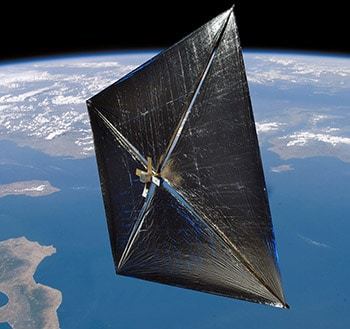With a Camera Measure Shape and Movement in Sails and Flexible Structures
With A Camera Blog Series

Introduction

Fig. 1 Model of easing sail
Flexible structures, such as sails, fabrics, flexible wings, and solar sails are very hard to measure because they are unstable. For example, the instability of the shape of a sail due to wind and luffing makes it difficult for sail designers and flow analysts to measure flying shapes of yachts and spinnakers in real sailing conditions. In a sail, the light fabric plays a critical role in generating the force that drives it, hence the need to optimize its shape. Similar difficulties exist with flapping wings, and gossamer space structures.
Accurate 3D descriptions of objects in the wind tunnel enable flow analysts to validate numerical predictions. Furthermore, flying shapes provide sailors with critical trimming tips that they can employ during racing competitions. For a long time, researchers have been looking for suitable methods for measuring shape and movement of flexible structures.
Application of Photogrammetry in sail shape acquisition

Fig. 2 – Spinnaker with targets
Various flying shape measurement techniques have been developed and tested. These measurement techniques include laser-based method, profilometric technique, and photogrammetric measurement. The laser-based technique requires time to scan a sailing object, and this makes it unsuitable for dynamic measurements. The photogrammetric method provides accurate 3D measurements at one instant in time, and this makes it a reliable source of information for validating numerical simulations. The PhotoModeler software provides such tools.
The photogrammetric technique involves generation of 3D descriptions of fluid-structure interactions from high resolution photographs. The fabric of the sailing object is fitted with markers at discrete points as shown in Figure 2. The high resolution images are captured simultaneously from different viewing angles using digital cameras. The photogrammetry algorithm converts 2D coordinates of points in the sailing object’s images into 3D coordinates points, which are then lofted to generate spline curves. A non-uniform rational b-spline surface is produced by lofting the spline curves. A detailed procedure is described in this Spinnaker Modeling Paper. The capture of shape over time and animated rendering shows the 3D model of a real spinnaker as it is trimmed, as shown in Figure 1 above.
The experiment requires at least three cameras, and each is calibrated before the experiment to ensure accuracy of the obtained measurements. You can find more resources on how you can enhance the accuracy of your photogrammetric measurement system here. The flying shapes obtained from photogrammetric measurements enable flow analysts and sail designers to validate analytical simulations and optimize the performance of flexible structures. This technique allows fast sampling, and it is cost-effective as compared to other techniques used for flexible structural monitoring.
Solar Sails and Space Structures

Fig. 3: Solar Sail – credit NASA
The flexibility and lightness of gossamer structures makes it difficult for researchers to measure their 3D static shapes. Sensors cannot be used because their weight can interfere with the dynamic characteristics and shapes of the ultra-weight structures. The laser-based technique is slow, and it is, therefore, likely to produce inaccurate measurements. Photogrammetry provides NASA and the aerospace industry with a suitable ground test method for measuring gossamer structures under various conditions. The technique allows researchers to measure such structures under stationary, vibrating, and deploying conditions. This article on NASA solar sails describes how a senior research engineer at NASA used photogrammetry to measure 3D static shapes of gossamer structures.
The 3D static shapes obtained from this non-contact measurement technique are used to validate analytical predictions obtained through advanced simulations. Using validated structural models gives NASA and the aerospace industry the confidence that the ultra-lightweight space structures will perform as planned when they are launched to the space. The measurements are also used for fine-tuning the designs of the deployment systems and evaluating their performance under dynamic loads. Measuring the 3D static shape of gossamer structures involves installing targets on the delicate membrane. However, it has been demonstrated that accurate photogrammetric measurements can be obtained by projecting targets on the delicate structure.
Micro-aircraft Flexible Wing Modeling

Fig. 4: Micro-AV Test Setup
Accurate modeling of the wing motion enable researchers to study the dynamics that are involved in flapping flight of micro aircraft. The measurements also enable them to study the effects of changing the shape of a wing during flight. Photogrammetry provides researchers with a suitable testing method for analyzing the performance of flapping wings under different conditions. These measurements are used by researchers for optimizing the designs of flapping wings for micro air vehicles (MAV). In this thesis on MAV, a non-intrusive photogrammetry technique that employs laser dot projection was used to measure the shape of a flapping wing.
Summary
The fluid-structure interaction between a light fabric and a complex flow complicates the process of measuring flying shapes. Photogrammetry provides an accurate technique of developing three-dimension descriptions for validating numerical simulations of objects in real conditions. Sail designers and flow analysts require 3D descriptions to optimize the design of the flexible parts of sailing objects. Photogrammetric measurements are also used by NASA and the aerospace industry for fine-tuning the designs of ultra-lightweight space structures. Additional engineering and scientific measurement scenarios can be found on the PhotoModeler Engineering Applications page.
